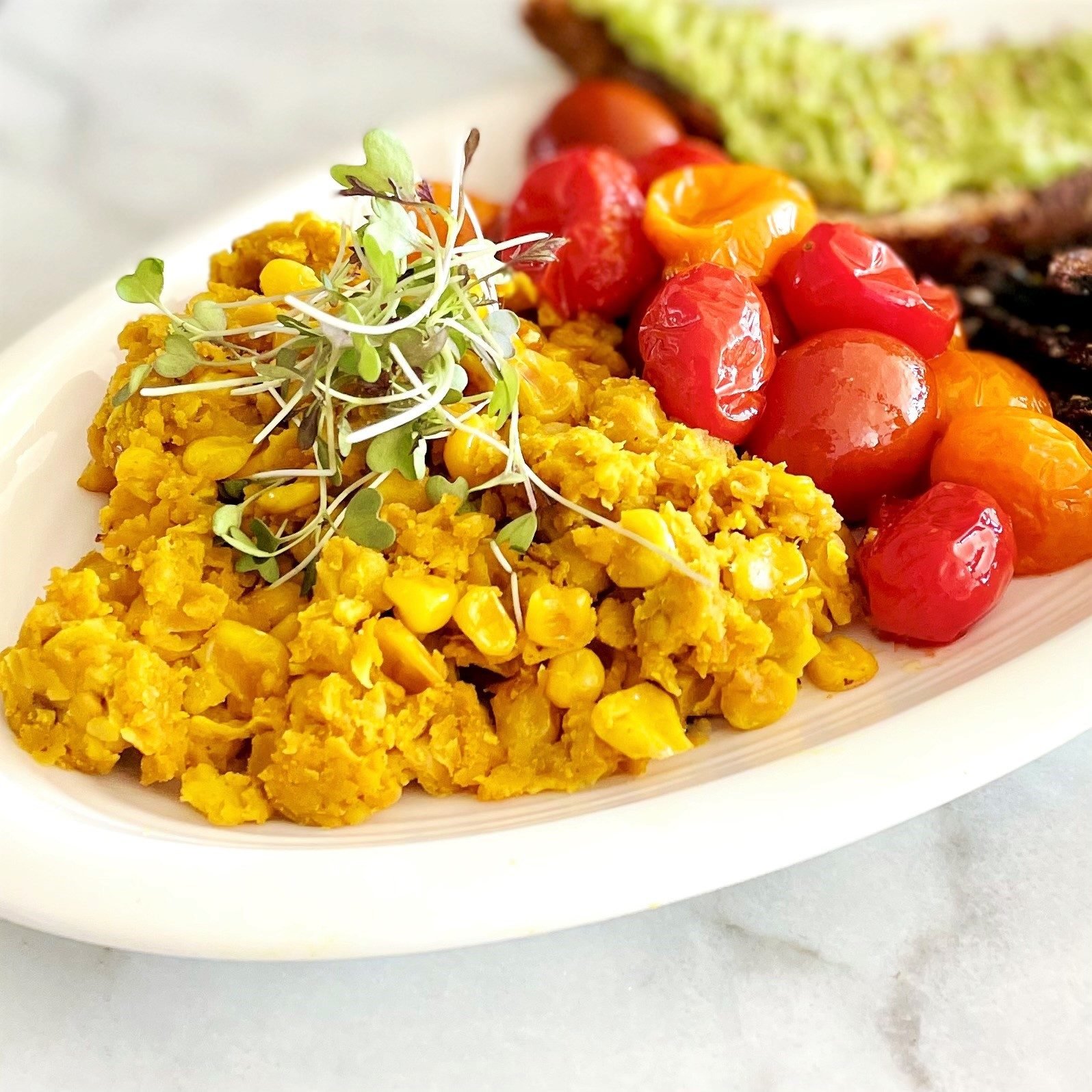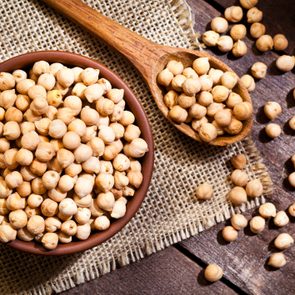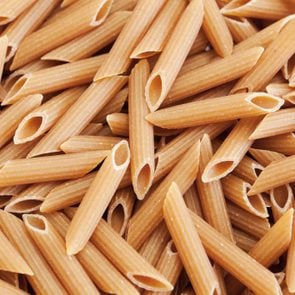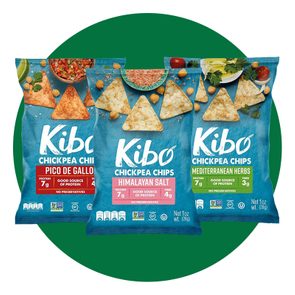What to Know About Chickpea Nutrition, Benefits, and How to Cook Them
Updated: May 18, 2021
Chickpeas are pulses that many people first discover in the form of hummus. Here's what to know about their nutrition, benefits, calories, and protein, as well as how to eat them. Added bonus: An easy vegan chickpea "scrambled egg" recipe you can try.
Our editors and experts handpick every product we feature. We may earn a commission from your purchases.
What are chickpeas?
If you’ve ever dipped into a bowl of hummus, you’ve eaten chickpeas. (Yes, crave-worthy, dippable foods can provide plenty of nutrition.)
Chickpeas are part of a nutrient-rich category of foods called pulses, which are the dry, edible seeds that are part of the legume family.
Dry peas, dry beans, and lentils are all part of this noteworthy group. They’re all excellent sources of plant-based protein, too. That’s right: this small, snackable pulse is a bona fide superfood.
Chickpeas are not just beige
When you think of chickpeas, you probably envision beige beans. These are also called garbanzo beans, and they’re just one variety of chickpea. Like a traffic stoplight, chickpeas also come in red, yellow, and green.
“While the most common type consumed in the United States, known as Kabuli, are cream-colored, there are multiple types and hues of chickpeas,” says Cynthia Sass, RD, a Los Angeles-based nutritionist who specializes in plant-based eating. “Smaller and darker Desi chickpeas pack a greater antioxidant punch—you’ll find them in Indian markets or specialty food stores.”
Since chickpeas originate from the Mediterranean region, you’re most likely to find them in dishes like curries, falafel, and, of course, hummus. But this pulse is also now readily grown in the United States, mainly in Montana, Washington, Idaho, and North Dakota.
According to the Agricultural Marketing Research Center, in North America, most Kabuli-type chickpeas are marketed as canned chickpeas for use in salads and as dry chickpeas and flour for use in baking.
Why chickpeas are a popular pulse
You may have noticed more chickpeas popping up in supermarket products and on restaurant menus over the past few years. There’s a reason for that: total U.S. acreage of chickpeas planted increased by a whopping 53 percent in 2017 from the prior year, according to the Agricultural Marketing Research Center data.
Whether that growth is sustainable remains to be seen; based on a 2020 U.S. Department of Agriculture Economic Research Service report, chickpea planting declined from 2019 to 2020 due in part to a large supply and trade-related issues.
Still, chickpeas are in increasingly high demand by consumers across America. “Chickpeas will grow in popularity as people continue to discover all of their delicious possibilities,” says Ellie Krieger, RDN, Food Network and PBS host, and award-winning cookbook author.
There are lots of reasons for their popularity. One is that they’re a cost-friendly food. Cost has been a key driver of food purchases during the pandemic.
Chickpeas also effortlessly fit into most eating plans, including the Mediterranean diet.
“They’re so incredibly nourishing and versatile—and, obviously, they fit into the plant-based diet trend that keeps growing,” says Sara Haas, RDN, a consultant culinary nutritionist and author of the Taco! Taco! Taco! cookbook.
They seem to offer something for everyone, says Sass. “In addition to their research-backed benefits, chickpeas check a number of boxes that consumers are interested in: they’re plant-based, eco-friendly, gluten-free, not a common allergen, affordable, readily available, and incredibly versatile,” she says.
(Try these chickpea snacks.)
Chickpeas nutrition facts
How nutrient-rich are chickpeas? Here’s what you’ll find, on average, in one cup of canned chickpeas after draining and rinsing them:
Calories: 210
Fat: 4 g (5 percent daily recommended value, or DV)
Sodium: 322 mg (14 percent DV)
Carbohydrate: 35 g (13 percent DV)
Fiber: 9.6 g (34 percent DV)
Sugars: 6 g
Protein: 11 g (21 percent DV)
Calcium: 65 mg (5 percent DV)
Iron: 1.5 mg (8 percent DV)
Manganese: 1.2 mg (53 percent DV)
You’ll get one-third of the fiber you need in a day from a cup of these pulses. The nutrient comes with an array of health-protective benefits. Not only that. but you’ll get almost a quarter of your daily dose of protein too.
As for sodium, you can reduce your intake by buying no-salt-added canned chickpeas. Or prepare dry chickpeas if you prefer to manage the amount of sodium yourself.
There’s more to this pulse than just a bunch of impressive numbers. “Chickpeas are also chock-full of antioxidants,” says Sass
Benefits of chickpeas
There’s no doubt that chickpeas are good for your health.
“According to a study published in the journal Nutrients, people who regularly consume chickpeas and/or hummus have higher intakes of several key nutrients,” says Sass. “These include fiber; vitamins A, E, and C; folate; magnesium; potassium; and iron.”
Does that mean eating chickpeas will boost your intake of those vitamins? Potentially. It may be that people who eat a more nutrient-packed diet are more likely to eat chickpeas. Either way, the petite pulses are a great source of nutrition.
They may help weight management
Haas says the sense of satiety provide by chickpeas’ fiber and protein can help prevent overeating.
“According to government data, chickpea/hummus consumers were 53 percent less likely to be obese,” says Sass. “They also had lower BMIs [body mass indexes] and waist measurements compared to non-chickpea/hummus eaters.”
They may help reproductive health
If you’re trying to get pregnant, chickpeas can play a helpful role there, too.
“There is a lot of research [like a 2018 study in Frontiers in Public Health] that points to a plant-based diet for improving fertility, so chickpeas check the box,” says Haas. “Swapping plant protein for some of your regular meat-based protein is a fertility-friendly option.”
They may help prevent type 2 diabetes
Chickpea consumption may be protective for a variety of chronic health conditions, including type 2 diabetes.
A study published in Nutrients in 2018 found that chickpeas contain bioactive compounds that can reduce insulin resistance, a major risk factor for type 2 diabetes.
In a study published in Nutrients in 2017, researchers found that pairing chickpeas with white rice led to less of a blood sugar response than eating white rice alone. The chickpeas essentially blunted the high glycemic index effect of the white rice. One thing to note: this was a very small study, involving only 12 women.
They are good for the planet
If you like to choose foods that are good for the planet, chickpeas are an earth-conscious pick.
Pulses, like chickpeas, are considered nitrogen-fixing crops. This means that they decrease the need for fertilizers, which therefore boosts their sustainability.
Risks and side effects
If you’re ready to pump up the pulses in your eating plan, good for you. But don’t rush to eat chickpeas in everything.
“You may experience more gas when you first up your chickpea intake, but over time, your body will adapt,” says Sass. “If you purchase canned chickpeas, rinsing them thoroughly can also help curb bloating.”
Make sure the chickpeas that you eat are cooked in some manner. (Canned beans are already cooked, by the way.) The act of cooking chickpeas increases the amount of protein and other nutrients that you can absorb while reducing or inactivating anti-nutrients (compounds that reduce or block nutrient absorption).
Discuss how to include more chickpeas into your eating plan with your doctor or registered dietitian nutritionist if you have a significant digestive disorder.
The basics of buying and using chickpeas
Based on a 2,000-calorie-per-day healthy eating pattern, the 2020 USDA Dietary Guidelines for Americans recommends a weekly serving of 1.5 cups of beans, peas, and lentils.
Get into the “half-cup habit” by eating a half cup of chickpeas three times a week.
To do that, pick any form that suits your cooking and eating style. You might pick canned, frozen, or dry packaged chickpeas, or even chickpea flour.
Or try an expanding offering of chickpea products, like hummus, roasted chickpea snacks, chickpea pasta, and falafel mixes. There are also prepared dishes featuring chickpeas, including soups, frozen meals, plant-based burgers, and even smoothies.
Canned chickpeas
If you have canned chickpeas, the culinary possibilities are endless—and can be quite easy. Just sprinkling them onto a salad makes that salad extra nutritious while pumping up the protein.
If you enjoy the art of cooking, prepare chickpeas into delightful recipes. Make your own hummus and serve it with fresh veggies. Use chickpeas to prepare a comforting curry or potpie. Or up the fun factor by making double-decker falafel sliders or dark chocolate hummus.
Dry chickpeas
Canned chickpeas are quick and easy, but some people prefer dried because they’re cheap and don’t have any preservatives. Before cooking, you’ll need to soak dried chickpeas in water. From there, you can cook them on a stovetop or in the oven or a pressure cooker or slow cooker.
Chickpea flour
Chickpea flour can be used as a nutrient-rich swap for all-purpose flour. Make a super-quick skillet flatbread with it. Or sneak it in as the flour of choice to create a better-for-you cookie.
Chickpea liquid
Don’t just toss the liquid in your chickpea can—it’s 100 percent edible and can be used in so many ways. Canned bean liquid is called aquafaba.
You can easily transform this liquid (just whip it!) into a plant-based egg replacement, whipped cream, mousse, mayonnaise, and more. With an electric mixer and a little cream of tartar, whip the aquafaba until it’s foamy, and then flavor it as you like.
Sass says she whips aquafaba into meringue and vegan chocolate mousse, or incorporates it into cocktails.
Look for these chickpea products and restaurant dishes
On your next grocery shopping trip, scout for chickpea products—you’ll be pleasantly surprised at what you find. Seek out interesting chickpea-based products like these:
- Hippeas Chickpea Tortilla Chips ($26, 6-pack)
- Biena Chickpea Puffs ($25, 12-pack)
- The Good Bean Chocolate-Covered Chickpeas ($18, 4-pack)
- Siete Chickpea Flour Tortillas ($65, 6-pack)
- Banza Plant-Based Mac ($22, 6-pack)
- Vana Green Chickpea Superfood Bowl ($30, 6-pack)
- The Live Green Co. Chickpea Burger Mix ($15)
- Melt Organic Mozzarella Garlic Herb Spread
Dining out or ordering takeout? Try palate-enticing items like these on a menu near you: chickpea fries, spicy stewed chickpeas, green chickpea hummus, garbanzos fritos (fried chickpeas with pimento), cecina (Italian chickpea pancakes), chickpea tagine, or a falafel bowl.
Chickpea prep tips from the experts
Are you a home cook? Do as food-loving nutritionists do. For everyday dishes featuring chickpeas, try the following tips from Krieger, Haas, and Sass.
Add to salads and roasted vegetables
“There is almost nothing the mighty chickpea can’t do,” says Krieger. She likes to put them on salads and roast them alongside veggies, turning those dishes into complete protein-packed meals. She also seasons and pan-fries chickpeas to eat as a snack (or buys chickpea snacks). They double as crunchy crouton alternatives for soups and salads.
Make a quick mash
Whip up a protein-packed snack Krieger loves—it’s fast and easy. Mash chickpeas with lemon juice, olive oil, salt, and pepper, then use spread over toast.
Puree into creamy sauces and spreads
“I love how creative you can be with them,” says Haas. She likes adding chickpeas to soups, salads, and bowls, as well as pureeing them into deliciously creamy sauces and spreads. There are a lot of different cultural preparations that showcase chickpeas’ versatility, so have fun experimenting with them.
Use in savory and sweet recipes
“Like most people, I enjoy chickpeas on salads and in hummus,” says Sass. “But I use them in many other ways, in both savory and sweet recipes.” She uses slightly mashed chickpeas in place of eggs in a veggie-packed breakfast scramble, and in place of animal protein in chilled “chicken-less” or “un-tuna” salad. Sass also creates baked chickpea cakes (like crab cakes), adds them to stews, and opts for chickpea flour when making pizza.
But she’s not limited to savory dishes. Sass transforms chickpeas into vegan cookie dough, dessert hummus, and baked goods. And she loves the chickpea ice cream trend.
“What can’t chickpeas do? The possibilities are endless,” she says.
(Also, check out these vegetarian and vegan meal prep tips.)
Chickpea recipes to try now
You’re now ready to indulge in chickpea-based cuisine. So, what’s the easiest way to begin? Pick a simple recipe and get cooking. Here are a few quickies to get you started.
- Breakfast: Krieger’s Mashed Chickpea Toast with Parsley and Capers
- Lunch: Haas’s Chickpea Salad With Tahini Dressing or Chickpea Artichoke Salad Sandwich
- Dinner: Sass’s Baked Chickpea Cakes Over Sesame Greens
- Snack: My Sweet-n-Salty Sesame-Roasted Chickpea Snacks
And you’ll definitely want to sauté up my recipe for Plant-Based Chickpea Eggs in the morning.
Plant-Based Chickpea ” Scrambled Eggs” Recipe

3 servings
Ingredients:
1 (15.5-ounce) can no-salt-added chickpeas (garbanzo beans)
2 tablespoons nutritional yeast flakes
3/4 teaspoon turmeric powder
1/2 teaspoon sea salt
1/4 teaspoon smoked paprika
1/4 teaspoon garlic powder
1/4 teaspoon freshly ground black pepper
2 tablespoons extra-virgin olive oil, divided
1 cup frozen corn, thawed and patted dry
1/4 cup microgreens of choice, or small fresh basil leaves
Instructions:
Drain the chickpeas, reserving 1/4 cup of the liquid from the can.
To a medium bowl, add the drained chickpeas, chickpea liquid, nutritional yeast, turmeric powder, sea salt, smoked paprika, garlic powder, and black pepper. Smash and stir with a fork until the mixture is evenly combined and slightly lumpy. Set aside.
Heat 1 tablespoon of the olive oil in a large cast iron or other stick-resistant skillet over medium-high heat. Add the corn and sauté until it begins to brown and pop, about 4 minutes. Add the remaining 1 tablespoon of olive oil and the smashed chickpea mixture, and sauté until the mixture is “scrambled” and lightly browned, about 4 to 5 minutes.
Garnish with the microgreens and serve.
Per serving: 290 calories, 12 g total fat, 1.5 g saturated fat, 0 g trans fat, 0 mg cholesterol, 410 mg sodium, 38 g total carbohydrate, 10 g dietary fiber, 4 g total sugars (includes 0 g added sugars), 12 g protein
























